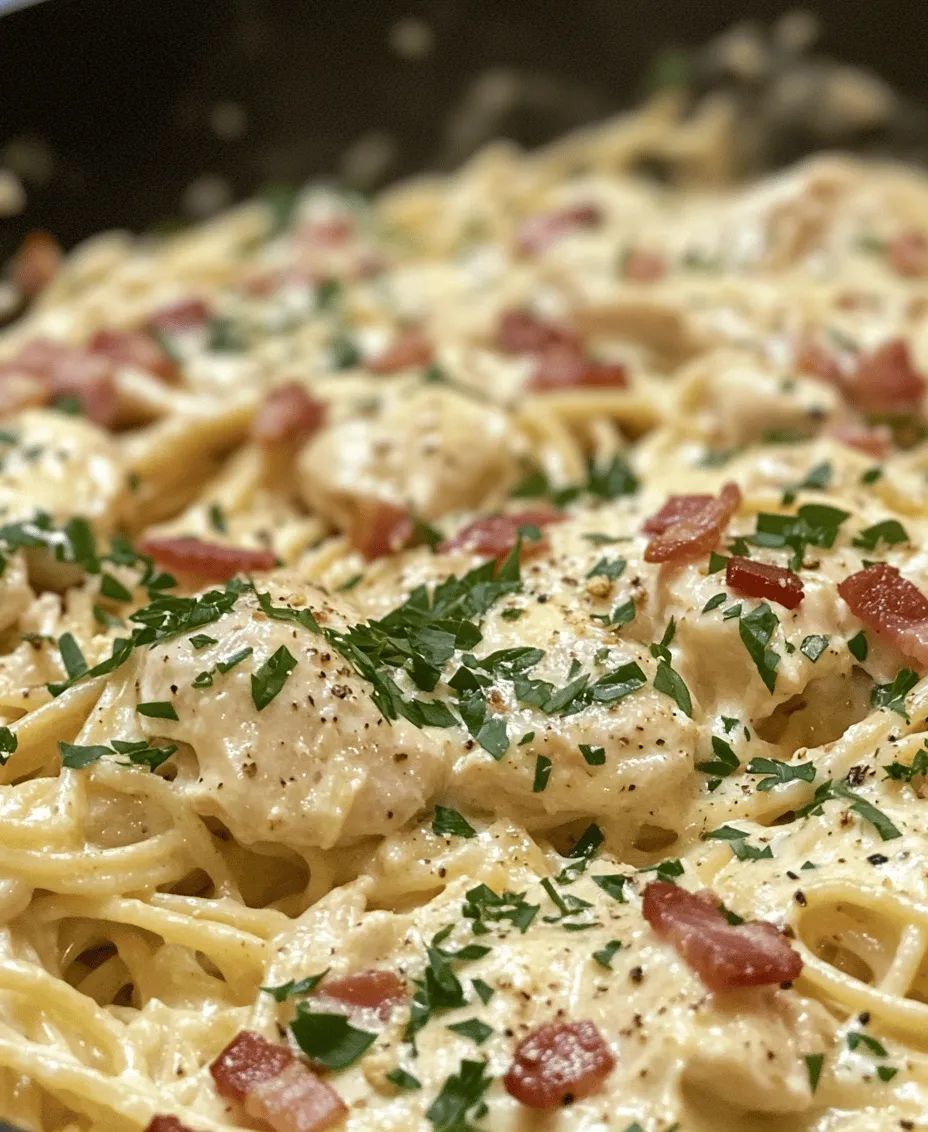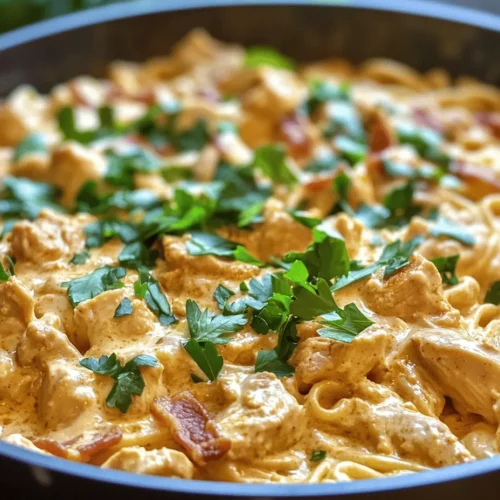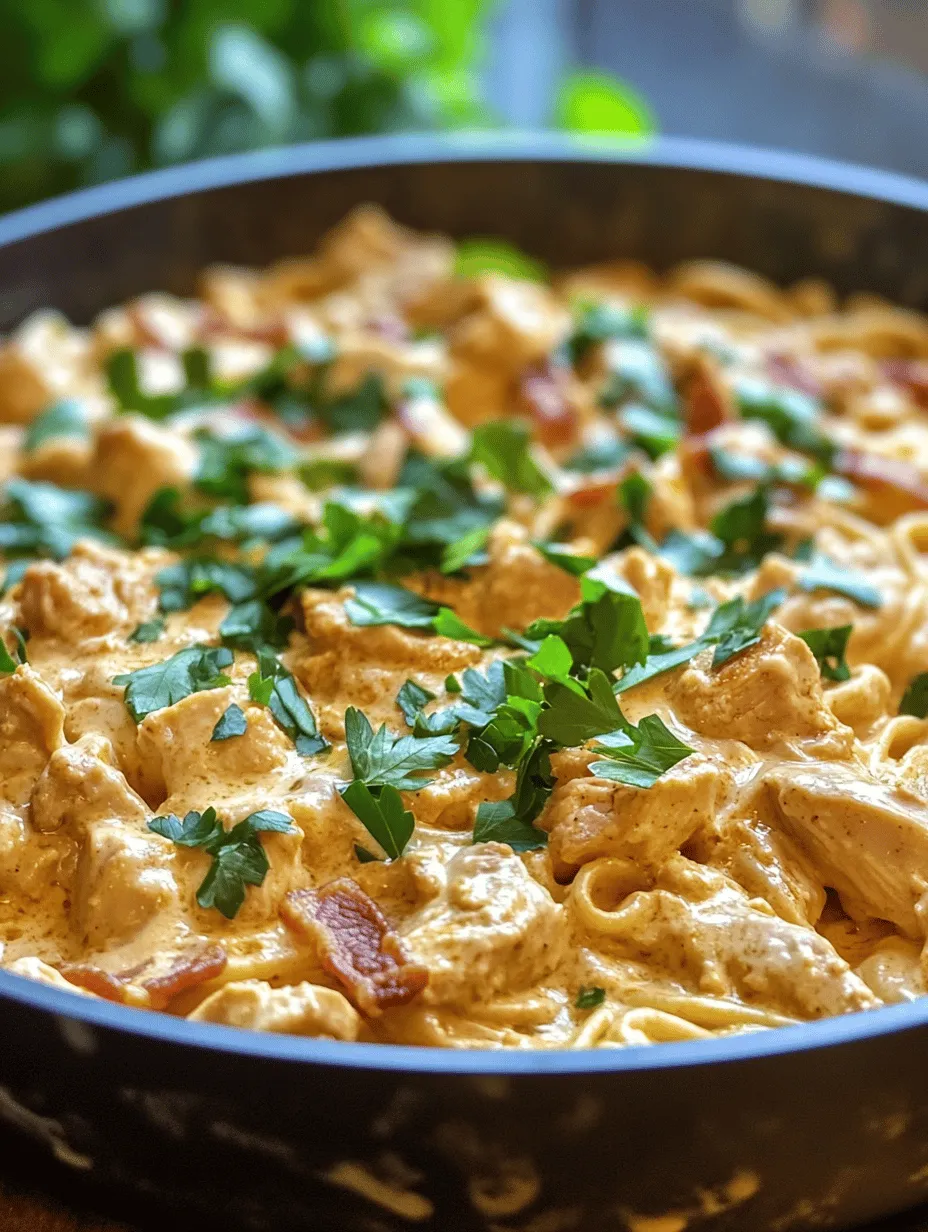In the realm of Italian cuisine, few dishes are as beloved and comforting as Chicken Carbonara. This rich and creamy pasta dish, traditionally made with pancetta or guanciale, has been adapted to include tender chicken, creating a satisfying meal that will impress both family and friends. The essence of Carbonara lies in its simplicity; with just a handful of quality ingredients, you can create a dish that is not only delicious but also filling and deeply satisfying.
Chicken Carbonara has gained widespread popularity due to its creamy texture and the savory depth it brings to the table. Originating from the central regions of Italy, this dish has evolved over time, allowing for various interpretations while still holding on to its authentic roots. The chicken adds a hearty element that complements the dish’s creamy sauce, making it an ideal choice for any occasion, whether it’s a casual family dinner or an elegant gathering.
In this article, we will explore the best-ever Chicken Carbonara recipe, breaking down each step to ensure you achieve the perfect balance of flavors and textures. We will delve into the rich history of Carbonara, the key ingredients that make this dish stand out, and provide you with a step-by-step guide to prepare a mouthwatering Chicken Carbonara that will become a staple in your culinary repertoire.
Understanding the Essentials of Chicken Carbonara
Exploring the Origin of Carbonara
The exact origins of Carbonara are somewhat murky, but it is widely believed to have emerged in the mid-20th century. Some food historians suggest that the dish was created by Italian charcoal workers, known as “carbonari,” hence the name Carbonara. Others argue that it was influenced by American soldiers stationed in Italy during World War II, who introduced ingredients like bacon and eggs into traditional Italian cooking.
Traditionally, Carbonara is made with guanciale, a type of cured pork cheek, and is enriched with eggs, Pecorino Romano cheese, and freshly cracked black pepper. However, modern interpretations often substitute pancetta or bacon for guanciale, making it more accessible for home cooks. The addition of chicken not only makes the dish heartier but also adds a new layer of flavor that pairs beautifully with the creamy sauce.
Over the years, Carbonara has undergone various adaptations, leading to the creation of numerous recipes that cater to different tastes and dietary preferences. Despite these variations, the core principles of Carbonara remain unchanged: simplicity and quality ingredients are key to achieving an authentic flavor.
Key Ingredients That Make This Recipe Stand Out
To create the best-ever Chicken Carbonara, it’s crucial to understand the role of each ingredient in the dish. Here’s a breakdown of the essential components that contribute to the richness and flavor of this iconic recipe:
– Pasta: The foundation of Carbonara is the pasta, and while spaghetti is the most commonly used type, fettuccine or linguine can also work wonderfully. The pasta should be cooked to al dente, providing a perfect base for the creamy sauce.
– Chicken: Tender, juicy chicken breasts are the star of this variation. They should be seasoned and cooked to perfection, adding a substantial and satisfying element to the dish.
– Bacon or Pancetta: This ingredient adds a depth of flavor and a delightful crunch. The choice between bacon and pancetta can slightly alter the dish’s overall taste, so choose based on your preference for smokiness and saltiness.
– Eggs: The creamy sauce is created by combining eggs with cheese, resulting in a rich, velvety texture that coats the pasta beautifully. Fresh, high-quality eggs are essential for the best results.
– Cheese: Pecorino Romano cheese is the traditional choice for Carbonara, providing a salty and tangy flavor. Grated Parmigiano-Reggiano can also be used or blended with Pecorino for a milder taste.
– Black Pepper: Freshly cracked black pepper is a crucial component, enhancing the dish’s flavor profile and providing a slight kick that balances the creaminess.
The importance of quality cannot be overstated when it comes to these ingredients. Opt for fresh, high-quality pasta, cheese, and meats to ensure that your Chicken Carbonara is as delicious as possible.
Step-by-Step Guide to Preparing Best-Ever Chicken Carbonara
Preparing the Pasta: The Foundation of the Dish
The first step in creating your Chicken Carbonara is to prepare the pasta. The choice of pasta can significantly affect the dish’s overall presentation and texture. While spaghetti is the classic choice, fettuccine offers a broader surface area for the sauce to cling to, resulting in each bite being perfectly coated.
1. Choosing the Right Pasta: When selecting your pasta, consider using fresh pasta if you can find it, as it cooks faster and has a delightful texture. However, dried pasta is perfectly acceptable and widely used. For this recipe, you can opt for either fettuccine or spaghetti, depending on your preference.
2. Cooking Tips for Achieving Al Dente Perfection: Fill a large pot with water and bring it to a rolling boil. Add a generous amount of salt to the water—this is your chance to season the pasta itself. Once the water is boiling, add the pasta and cook according to the package instructions, usually around 8-10 minutes for dried pasta, until it is al dente. Remember, the pasta will continue to cook slightly after being drained, so it’s better to err on the side of undercooking.
3. Importance of Reserving Pasta Water: Before draining the pasta, make sure to reserve about a cup of the starchy pasta water. This water will be a vital component in achieving the desired creamy consistency of your Carbonara sauce. The starch in the water helps emulsify the sauce, ensuring it clings beautifully to the pasta.
Cooking the Chicken: Achieving Perfect Flavor and Texture
Next, it’s time to prepare the chicken, which will add a wonderful heartiness to your Carbonara.
1. Choosing the Best Chicken Breasts: Look for boneless, skinless chicken breasts for the best results. You can also use chicken thighs for a richer flavor, but ensure they are cooked thoroughly. Make sure the chicken is fresh and of high quality to enhance the overall taste of the dish.
2. Tips for Seasoning and Sautéing Chicken: Begin by patting the chicken breasts dry with paper towels to help achieve a nice sear. Season both sides generously with salt and freshly cracked black pepper. In a large skillet, heat a tablespoon of olive oil over medium-high heat. Once the oil is shimmering, add the chicken breasts. Cook for about 5-7 minutes per side, depending on thickness, until they are golden brown and cooked through. Use a meat thermometer to check for doneness; the internal temperature should reach 165°F (75°C).
3. Techniques for Ensuring Juiciness and Tenderness: To ensure that your chicken remains juicy, avoid overcooking it. You can also let the chicken rest for a few minutes after cooking; this allows the juices to redistribute, making for a more flavorful bite. Once rested, slice the chicken into bite-sized pieces or strips, ready to be incorporated into your Carbonara.
Crispy Bacon: Adding Depth of Flavor
The addition of bacon or pancetta is what truly elevates Chicken Carbonara, providing a salty, savory flavor that balances the richness of the dish.
1. The Role of Bacon in Carbonara: In this recipe, the crispy bacon adds texture and depth, making each bite more satisfying. The rendered fat from the bacon also serves as a flavorful base for the sauce, enhancing the overall taste of the dish.
2. Tips for Cooking Bacon to the Perfect Crispness: To achieve that perfect crispness, use a large skillet and cook the bacon over medium heat. Cut the bacon into small pieces before adding it to the skillet. Stir occasionally until the bacon is golden brown and crispy, about 5-7 minutes. Be careful not to burn it, as burnt bacon can impart a bitter flavor to your dish.
Once the bacon is cooked, use a slotted spoon to remove it from the skillet, leaving the rendered fat behind. This fat will add incredible flavor to the other components of your Chicken Carbonara.
With the pasta, chicken, and bacon ready, you are well on your way to creating an unforgettable Chicken Carbonara. In the following sections, we will dive deeper into assembling the dish, creating the luscious sauce, and perfecting the final presentation. Stay tuned for the complete guide to achieving the best-ever Chicken Carbonara that will leave your guests asking for seconds.

How to Manage Bacon Fat for Added Flavor
Bacon is the heart of a classic carbonara, imparting a smoky, savory depth to the dish. However, managing the bacon fat properly is crucial for achieving the best flavor without overwhelming the dish. After cooking your bacon until it’s perfectly crispy, you’ll want to reserve some of that rendered fat to use in your sauce.
Tip: Use a slotted spoon to transfer the bacon to a paper towel-lined plate to drain excess fat. Leave about 2 tablespoons of bacon fat in the skillet. This flavorful fat will serve as the base for sautéing your garlic, enhancing the overall richness of the dish.
Sautéing Garlic: The Aromatic Base
Garlic is essential in Italian cooking, acting as a flavor enhancer that brings warmth and aroma to the dish. In carbonara, it plays a crucial role in building the foundation of flavors.
Importance of Garlic in Italian Cooking
Garlic not only adds depth but also balances the richness of the bacon and cream. It’s a staple ingredient that can elevate any dish when used correctly.
Timing and Technique for Sautéing Without Burning
To achieve the perfect garlic flavor, sauté it in the reserved bacon fat over medium heat. Be careful to not let it burn, as burnt garlic can impart a bitter taste. Aim for a golden hue and a fragrant aroma, which typically takes about 1-2 minutes. Stir continuously, and as soon as the garlic turns golden, it’s time to move on to the next step in crafting your creamy sauce.
Crafting the Creamy Sauce: The Heart of Carbonara
The creamy sauce is what makes carbonara so indulgent and comforting. Balancing its creaminess with richness is key to achieving that luxurious mouthfeel.
Balancing Creaminess with Richness: Heavy Cream and Eggs
While traditional carbonara relies solely on eggs and cheese for creaminess, adding a splash of heavy cream can enhance the texture, making it smoother. This combination creates a velvety sauce that clings beautifully to the pasta.
Importance of Freshly Grated Parmesan Cheese
Using freshly grated Parmesan cheese is non-negotiable. Pre-packaged cheese often contains anti-caking agents that prevent it from melting smoothly. Freshly grated cheese will melt effortlessly, enriching your sauce with its nutty and salty notes.
Tips for Whisking the Sauce to Perfection
In a separate bowl, whisk together the eggs, heavy cream, and a generous amount of freshly grated Parmesan cheese. Whisk until the mixture is smooth and well combined. This step is crucial; a well-aerated mixture will create a light and creamy sauce that envelops the pasta beautifully.
Combining the Ingredients: Creating the Perfect Harmony
Combining the ingredients at the right time is essential to achieving a harmonious dish without clumping.
Timing for Adding Chicken, Bacon, and Pasta
Once your garlic is fragrant and your sauce is ready, it’s time to combine everything. First, add the cooked chicken and crispy bacon back to the skillet, allowing them to warm slightly in the garlic fat. This step will infuse the chicken and bacon with even more flavor.
Next, add the drained pasta directly to the skillet, ensuring you reserve 1 cup of the pasta cooking water beforehand. The hot pasta will help to warm the sauce, creating a silky finish.
Techniques for Mixing Without Clumping
To avoid clumping, work quickly. Remove the skillet from the heat before adding the egg and cream mixture. This prevents the eggs from scrambling. Pour the sauce over the pasta, using tongs to toss everything together gently. This method will help distribute the sauce evenly without clumping.
Using Reserved Pasta Water for Adjusting Sauce Consistency
If your sauce seems too thick, gradually add reserved pasta water, a little at a time, until you reach your desired consistency. This starchy water not only adjusts the thickness of the sauce but also helps it adhere to the pasta beautifully.
Serving Your Best-Ever Chicken Carbonara
Once your Chicken Carbonara is perfectly combined and creamy, it’s time to present it in a way that makes it as visually appealing as it is delicious.
Presentation Tips for an Eye-Catching Dish
Importance of Garnishing with Parsley and Cheese
A sprinkle of fresh parsley adds a pop of color, while an extra dusting of Parmesan cheese elevates the visual appeal. Use a microplane or fine grater to achieve a delicate snowfall of cheese over the top. Garnishing not only makes the dish look beautiful but also enhances the flavors.
Serving Suggestions for a Complete Meal Experience
Serve your Chicken Carbonara immediately while it’s hot. Pair it with a simple side salad dressed with a light vinaigrette to balance the richness of the pasta. A slice of crusty garlic bread would also complement the meal perfectly, allowing you to soak up any leftover sauce.
Pairing Suggestions: What to Serve with Chicken Carbonara
When it comes to pairing suggestions, consider both wine and side dishes that will complement the richness of your Chicken Carbonara.
Wine Pairings that Complement the Dish
For an ideal wine pairing, opt for a crisp white wine like Pinot Grigio or a light-bodied red such as Chianti. These wines have enough acidity to cut through the creaminess of the carbonara, enhancing the overall dining experience. If you prefer sparkling options, a dry Prosecco would also be delightful.
Side Dishes that Balance the Richness of Carbonara
Alongside your Chicken Carbonara, consider serving steamed vegetables like asparagus or broccoli. Their freshness and slight bitterness will provide a nice contrast to the rich pasta. Alternatively, a simple tomato salad with basil and mozzarella can brighten the palate between bites.
Conclusion: The Joy of Homemade Chicken Carbonara
As you enjoy this best-ever Chicken Carbonara, take a moment to appreciate the process and flavors that come together to create such a beloved dish. Whether for a special occasion or a cozy dinner at home, mastering this recipe will not only satisfy your cravings but also impress those you share it with. The joy of cooking lies in the love and care you put into each meal, making this Chicken Carbonara a true celebration of Italian culinary tradition.
This recipe invites you to embrace the art of cooking, encouraging you to experiment and make it your own. The creamy sauce, the crispy bacon, and tender chicken come together in a way that will have your family and friends asking for seconds. So gather your ingredients, follow these steps, and prepare to fall in love with your best-ever Chicken Carbonara.



